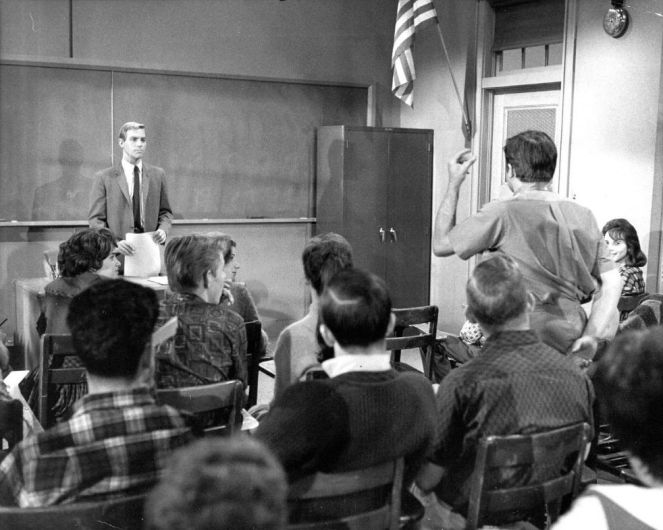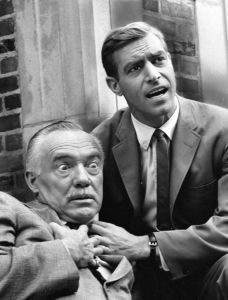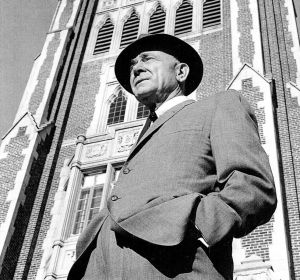
“A practical idealist, a man who wants nothing more than a chance to take a crack at ignorance eight or ten hours a day, a great hero for the public.” That is how television writer-producer E. Jack Neuman conceived the central character for a series idea he was discussing with his friend, director Boris Sagal, with whom Neuman had previously worked on a 1962-63 NBC-TV program he created entitled Sam Benedict. Despite critically lauded plaudits for the show, which starred Oscar-winning actor Edmond O’Brien as a dedicated trial lawyer, Benedict suffered in the ratings due to its unfortunate scheduling opposite Jackie Gleason and His American Scene Magazine. The two friends were discussing ideas for their next project and Sagal asked: “Hey, how about doing a series about a high school teacher?”
“Well, it doesn’t sound so good to me,” Neuman returned. “What do we do when we’re finished with smoking in the school basement, the star half back who is a lousy English student and the kids who run off to get married?” But after giving it additional thought—including discussions with school administrators to get their input—Neuman did a 180 and thought the idea a solid one. “Young people today are begging for discipline for understanding,” he would later recall in an interview. “They aren’t the way they were shown in Dobie Gillis or Our Miss Brooks.”
 With the understanding that this last statement is not necessarily a bad thing, Neuman and Sagal would go on to create Mr. Novak, an hour-long dramatic series about an idealistic English teacher (James Franciscus) that set out to present individuals toiling in the country’s educational system in a positive, realistic fashion. Novak’s original network run was a brief one; it ran only two seasons from 1963 to 1965, and Nielsens-wise, it ran into the same ratings trouble that had plagued the earlier Sam Benedict (Novak frequently played second fiddle to the popular Combat! on ABC). But during its time on the air, it attracted a loyal, devoted audience despite the stiff competition…and earned high praise from educational organizations with numerous citations and awards (Mr. Novak even garnered a prestigious Peabody Award).
With the understanding that this last statement is not necessarily a bad thing, Neuman and Sagal would go on to create Mr. Novak, an hour-long dramatic series about an idealistic English teacher (James Franciscus) that set out to present individuals toiling in the country’s educational system in a positive, realistic fashion. Novak’s original network run was a brief one; it ran only two seasons from 1963 to 1965, and Nielsens-wise, it ran into the same ratings trouble that had plagued the earlier Sam Benedict (Novak frequently played second fiddle to the popular Combat! on ABC). But during its time on the air, it attracted a loyal, devoted audience despite the stiff competition…and earned high praise from educational organizations with numerous citations and awards (Mr. Novak even garnered a prestigious Peabody Award).
 The history of this groundbreaking show is presented in fascinating detail in a new book by author-musician Chuck Harter, Mr. Novak: An Acclaimed Television Series. Profusely illustrated (many of the photos in this post were liberated from Chuck’s book), this Bear Manor Media release is one of the very best books written about a television program that I can recall in recent memory. Harter brings the same dedication to chronicling Mr. Novak that he did when he co-wrote (with Michael J. Hayde) a sensational book on one of the true silent comedy greats, Little Elf: A Celebration of Harry Langdon. Novak is a treasure trove of information about an unjustly neglected series, with a meticulously detailed account of the show’s production history that is supplemented with interviews from folks who worked on the show. Director Richard Donner, who helmed several of Mr. Novak’s installments, contributes an introduction to the book and two actors who guested on the program, the late Martin Landau and Walter Koenig, kick in with a foreword and afterward respectively.
The history of this groundbreaking show is presented in fascinating detail in a new book by author-musician Chuck Harter, Mr. Novak: An Acclaimed Television Series. Profusely illustrated (many of the photos in this post were liberated from Chuck’s book), this Bear Manor Media release is one of the very best books written about a television program that I can recall in recent memory. Harter brings the same dedication to chronicling Mr. Novak that he did when he co-wrote (with Michael J. Hayde) a sensational book on one of the true silent comedy greats, Little Elf: A Celebration of Harry Langdon. Novak is a treasure trove of information about an unjustly neglected series, with a meticulously detailed account of the show’s production history that is supplemented with interviews from folks who worked on the show. Director Richard Donner, who helmed several of Mr. Novak’s installments, contributes an introduction to the book and two actors who guested on the program, the late Martin Landau and Walter Koenig, kick in with a foreword and afterward respectively.
I had only a passing familiarity with Mr. Novak (mostly what I gleaned from reference books on television) when Chuck e-mailed me to ask if I’d review the book for the blog. To give me an additional assist in this endeavor, he sent me six episodes of the show (on DVD) so I could familiarize myself, including the pilot, “First Day, First Year.” In this inaugural episode, we meet John Novak (Franciscus), a young English instructor newly hired to teach at Jefferson High School. Novak and his fellow newbies (who include Ed Asner in a guest role) are given sound advice from Jefferson’s principal, Albert Vane (Dean Jagger): “Don’t hang a sign on your face that says ‘PAL’ and above all don’t become personally involved with any of your students.”

It’s advice that Novak, unfortunately, is destined to ignore. On Novak’s first day, a student (Lee Kinsolving) runs into the teacher’s automobile with his own car…and though he informs Novak he’ll incur the cost of repairs, the student also clues the instructor that he’s dropping out of school; he’s doing all right running his own automobile body shop. The youth’s attitude toward higher education has been shaped by his father (Paul Genge), a “self-made man” who now runs a successful construction business.
Novak is determined to change the student’s mind about making what he feels will be a terrible mistake—even though Principal Vane admonishes him, telling Novak Jefferson High has counselors to handle these situations. But Novak will not be deterred from his course of action, and wins the day in persuading the student to stay in school, fool (the impressionable youth is partly persuaded by observing that his father, while a bidness success, is a terrible person). As Vane observes Novak teaching through the window of the closed classroom door, he remarks to his female assistant: “He’s a born teacher.”
“How do you know?” she asks. “He knows when to break the rules” is Vane’s reply.

That last statement could easily apply to the television show itself. Mr. Novak broke new ground in its nuanced tackling of controversial subjects against a high school background, from drug addiction (“Day in the Year”) to racial intolerance (“A Single Isolated Incident”) to suicide (“The Tower”). “Day in the Year” was among the episodes Chuck sent me to watch, as were two additional episodes that were particularly outstanding. “Pay the Two Dollars,” one of two episodes in the series that featured Martin Landau (the other being “Enter a Strange Animal,” a second-season installment), has Novak being sued by the father (Macdonald Carey) of a student (Tom Lowell) who claims the teacher broke his arm as Novak attempted to break up a fight. Landau plays a lackadaisical lawyer who keeps telling Novak to settle the dispute out of court…but our idealistic hero, knowing he’s done nothing wrong, insists on taking a principled stand. (This one features Beau Bridges in a small role as one of the student’s buddies, and Tim McIntire also appears uncredited as a student.)

“The Death of a Teacher”—an episode directed by Donner—tells the tale of a beloved instructor (Frank Albertson) who is felled by an aneurysm while climbing a stairwell with Novak, and his death has a devastating effect on Jefferson High’s students and faculty. The individual most shaken up is Frank Dever (Harry Townes), who’s convinced that his deceased colleague’s frenetic schedule and dedicated drive to his profession is what killed him…and he wants out before the same fate befalls him. Dever has a change of heart when he learns that the teacher’s widow (Phyllis Hill) is returning to teach in her husband’s stead…and actor Townes has an amusing scene trying to retrieve the letter of resignation he’s handed off to Principal Vane’s assistant (Marjorie Corley). (I also liked how the title of the episode refers not only to the instructor’s physical death, but the symbolic disillusionment of his friend.)

Mr. Novak made James Franciscus a teen idol—he even wrote a series of advice columns for TEEN Magazine while the show aired—but the actor had trouble during Novak’s run with the tabloid press, who delighted in fabricating stories about Franciscus (that he “feuded” with co-star Jagger, for starters). Jagger, whose acting impresses me more than Franciscus’ (I like how the Vane character projects just the right amount of authority without being a martinet…and how he’s often unsure he’s making the right decisions), would receive two Emmy acting nominations for his work on the series (the show was also nominated in its first season for Outstanding Program Achievement in the Field of Drama). The show attracted big-name guest stars, familiar names like Eddie Albert, Frankie Avalon, Robert Culp, Kim Darby, Howard Duff, and Celeste Holm; the OTR fan in me got a kick out of seeing the likes of Larry Thor (who had a recurring role as Mr. Hendriks) and Lurene Tuttle (who does a funny bit in an episode called “The Risk” as a mother giving Principal Vane hell about her son).

Despite the consistently high quality of its writing, directing, and acting, life was not all sunshine, lollipops, and rainbows on Mr. Novak; its production history was a troubled one, with Neuman being replaced in the second season as executive producer by future Hawaii Five-O creator Leonard Freeman (it’s speculated that the suits at MGM Television wanted someone a little more malleable with regards with the direction they wanted the series to go), and several members of the cast departing after salary disputes and gripes about their characters’ participation in the show (both Jeanne Bal, who played vice principal Jean Pagano in Season 1, and her replacement, Phyllis Avery, had problems with The Powers That Be). Jagger wound up leaving the show due to medical issues and was replaced toward the end of Season 2 by future Penguin Burgess Meredith as principal Martin Woodbridge.
Harter’s book gives you the lowdown on all this and much more; there’s an episode guide and a list of the awards the show won (I picture Neuman and his staff just showing up with a large sack to collect their prizes), but you’ll also find in the appendix the “writers’ guide” penned by Neuman (outlining the characters and such) and a treatment for a Mr. Novak script that, sadly, was thumbed down by NBC. “The Rich Who are Poor,” written by Neuman, was a well-written slice of drama about the topic of venereal disease that would have started on Novak and concluded on Dr. Kildare, a show that E. Jack developed for television (he also wrote a few scripts for the radio version as well).

We’ve been quite fortunate that Warner Home Video has released Kildare to DVD…but the even better news is that the company has announced that the first season of Mr. Novak will also be getting the disc treatment in 2018. This is sensational to hear; after its network run, Novak wasn’t syndicated like other TV programs due to its brief run of episodes (sixty in all) and because a stingy MGM wasn’t wild about coughing up residual money to stars Franciscus and Jagger (they had negotiated a contract where their initially low salaries would be compensated by the cash they raked in from reruns). Excepting a brief period from 1988 to 1990 when Novak aired on TNT (the episodes Chuck sent me have the TNT logo, which tickled me to death), the show has been MIA when it comes to The Old Syndication Home. I’m giddy about other folks unfamiliar with Mr. Novak discovering what a truly incredible program it was, and I profusely thank Chuck Harter for giving me an opportunity to read about this exemplary series.

I really wish Mr. Novak could be made available on cable today as a tutorial for today’s high schoolers. In more modern times, we’ve seen mostly sitcoms set in high schools (i.e. Welcome Back, Kotter, Head of the Class, Saved By The Bell), not dramas, and we could use a few more high school dramas. The abomination known as Riverdale doesn’t count.
LikeLiked by 1 person
I am in complete agreement with you on this, hob. I’m hoping that when it’s released to DVD next year than an outlet like MeTV might grab it for their schedule (it would be perfect for them).
LikeLike
That High School looks very familiar. Room 222?
LikeLiked by 1 person
There are similarities between the two shows but MR. NOVAK’s fictional “Jefferson High” was actually filmed at John Marshall High School in Los Angeles for the pilot, and then a set was built on the MGM lot for the remainder of the series (though the exteriors continued to be filmed at John Marshall). ROOM 222’s “Walt Whitman High” was a combination of filming at 20th Century-Fox and Los Angeles High School.
LikeLike